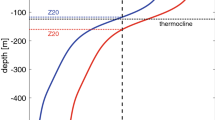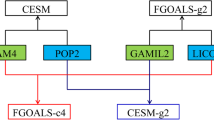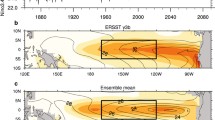Abstract
The CMIP model simulations show wide spread uncertainties in ENSO statistics and dynamics. In this study, we use the concept of the linear recharge oscillator (ReOsc) model to diagnose the ENSO-dynamics in CMIP3 and CMIP5 model simulations. The ReOsc model parameters allow us to quantify SST and thermocline damping, SST coupling to thermocline and vice-versa, sensitivity to wind stress and heat flux forcings and separate atmospheric from oceanic processes. Our results show that the ENSO-dynamics and their diversity within the CMIP ensemble can be well represented with the linear recharge oscillator model diagnostics. We also illustrate that the ENSO dynamics show larger biases relative to observations and spread within the models than simple large-scale statistics such as SST standard deviation would suggest. The CMIP models underestimate the atmospheric positive and negative feedbacks, they have compensating atmospheric and oceanic errors, the thermocline damping is too strong and stochastic noise forcings in models is too weak. The CMIP5 models show only marginal improvements relative to CMIP3. The results suggest that models can still be significantly improved and our analysis gives directions to what needs to be improved.










Similar content being viewed by others
References
Bayr T, Latif M, Dommenget D, Wengel C, Harlaß J, Park W (2017) Mean-state dependence of ENSO atmospheric feedbacks in climate models. Clim Dyn. https://doi.org/10.1007/s00382-017-3799-2
Bellenger H, Guilyardi E, Leloup J, Lengaigne M, Vialard J (2014) ENSO representation in climate models: from CMIP3 to CMIP5. Clim Dyn 42:1999–2018
Bjerknes J (1969) Atmospheric teleconnections from the equatorial Pacific. Mon Wea Rev 97:163–172
Brown JN, Fedorov AV (2008) Mean energy balance in the tropical Pacific Ocean. J Mar Res 66:1–23
Burgers G, Jin FF, van Oldenborgh GJ, 2005: The simplest ENSO recharge oscillator. Geophys Res Lett 32
Collins M et al (2010) The impact of global warming on the tropical Pacific ocean and El Nino. Nat Geosci 3:391–397
Dee DP et al (2011) The ERA-Interim reanalysis: configuration and performance of the data assimilation system. Q J R Meteorolog Soc 137:553–597
Dommenget D (2010) The slab ocean El Nino. Geophys Res Lett 37
Dommenget D, Haase S, Bayr T, Frauen C (2014) Analysis of the Slab Ocean El Nino atmospheric feedbacks in observed and simulated ENSO dynamics. Clim Dyn 42:3187–3205
England MH et al (2014) Recent intensification of wind-driven circulation in the Pacific and the ongoing warming hiatus. Nat Clim Change 4:222–227
Frauen C, Dommenget D (2010) El Nino and La Nina amplitude asymmetry caused by atmospheric feedbacks. Geophys Res Lett 37
Frauen C, Dommenget D (2012) Influences of the tropical Indian and Atlantic Oceans on the predictability of ENSO. Geophys Res Lett 39
Guilyardi E (2006) El Nino-mean state-seasonal cycle interactions in a multi-model ensemble. Clim Dyn 26:329–348
Jansen MF, Dommenget D, Keenlyside N (2009) Tropical atmosphere–ocean interactions in a conceptual framework. J Clim 22:550–567
Jin FF (1997a) An equatorial ocean recharge paradigm for ENSO .1. Conceptual model. J Atmos Sci 54:811–829
Jin FF (1997b) An equatorial ocean recharge paradigm for ENSO. 2. A stripped-down coupled model. J Atmos Sci 54:830–847
Jin FF, Kim ST, Bejarano L (2006) A coupled-stability index for ENSO. Geophys Res Lett 33
Kim D, Kug JS, Kang IS, Jin FF, Wittenberg AT (2008) Tropical Pacific impacts of convective momentum transport in the SNU coupled GCM. Clim Dyn 31:213–226
Kim ST, Cai WJ, Jin FF, Yu JY (2014) ENSO stability in coupled climate models and its association with mean state. Clim Dyn 42:3313–3321
Kociuba G, Power SB (2015) Inability of CMIP5 Models to simulate recent strengthening of the Walker circulation: implications for projections. J Clim 28:20–35
Latif M et al (2001) ENSIP: the El Nino simulation intercomparison project. Clim Dyn 18:255–276
Levine AF, Z. MJ, McPhaden (2015) The annual cycle in ENSO growth rate as a cause of the spring predictability barrier. Geophys Res Lett 42:5034–5041
Lloyd J, Guilyardi E, Weller H, Slingo J (2009) The role of atmosphere feedbacks during ENSO in the CMIP3 models. Atmos Sci Lett 10:170–176
McGregor S, Timmermann A, Stuecker MF, England MH, Merrifield M, Jin FF, Chikamoto Y (2014) Recent Walker circulation strengthening and Pacific cooling amplified by Atlantic warming. Nat Clim Change 4:888–892
Meehl GA et al (2007) The WCRP CMIP3 multimodel dataset—a new era in climate change research. Bull Am Meteorol Soc 88:1383-+
Rayner NA et al (2003) Global analyses of sea surface temperature, sea ice, and night marine air temperature since the late nineteenth century. J Geophys Res Atm 108
Reichler T, Kim J (2008) How well do coupled models simulate today’s climate? Bull Am Meteorol Soc 89:303
Smith NR (1995) An improved system for tropical ocean subsurface temperature analyses. J Atmos Ocean Tech 12:850–870
Suarez MJ, Schopf PS (1988) A delayed action oscillator for Enso. J Atmos Sci 45:3283–3287
Taylor KE, Stouffer RJ, Meehl GA (2012) An overview of Cmip5 and the experiment design. Bull Am Meteorol Soc 93:485–498
van Oldenborgh GJ, Philip SY, Collins M (2005) El Nino in a changing climate: a multi-model study. Ocean Sci 1:81–95
Yu LS, Weller RA (2007) Objectively analyzed air–sea heat fluxes for the global ice-free oceans (1981–2005). Bull Am Meteorol Soc 88:527-+
Yu YS, Dommenget D, Frauen C, Wang G, Wales S (2016) ENSO dynamics and diversity resulting from the recharge oscillator interacting with the slab ocean. Clim Dyn 46:1665–1682
Zebiak SE, Cane MA (1987) A model El-Nino Southern oscillation. Mon Weather Rev 115:2262–2278
Zelle H, van Oldenborgh G, Dijkstra H (2005) El Niño and greenhouse warming: results from ensemble simulations with the NCAR CCSM. J Clim 18:4669–4683
Acknowledgements
We are grateful and thank Tobias Bayr, Shayne McGregor, Sarah Perry, Peter van Rensch and Christian Wengel for their suggestions and comments. This study was supported by the ARC project “Beyond the linear dynamics of the El Nino Southern Oscillation”, Australian Research Council (Grant no. DP120101442) and the ARC Centre of Excellence for Climate System Science, Australian Research Council (Grant no. CE110001028). The work presented here has a long history going back to 2007 with a number of people contributing to the analysis over time that we like to acknowledge here: Malte Jansen, Claudia Frauen, Simona Trefalt, Chevillard Jeanne and Payan Timothée and Yanshan Yu.
Author information
Authors and Affiliations
Corresponding author
Electronic supplementary material
Below is the link to the electronic supplementary material.
Rights and permissions
About this article
Cite this article
Vijayeta, A., Dommenget, D. An evaluation of ENSO dynamics in CMIP simulations in the framework of the recharge oscillator model. Clim Dyn 51, 1753–1771 (2018). https://doi.org/10.1007/s00382-017-3981-6
Received:
Accepted:
Published:
Issue Date:
DOI: https://doi.org/10.1007/s00382-017-3981-6




